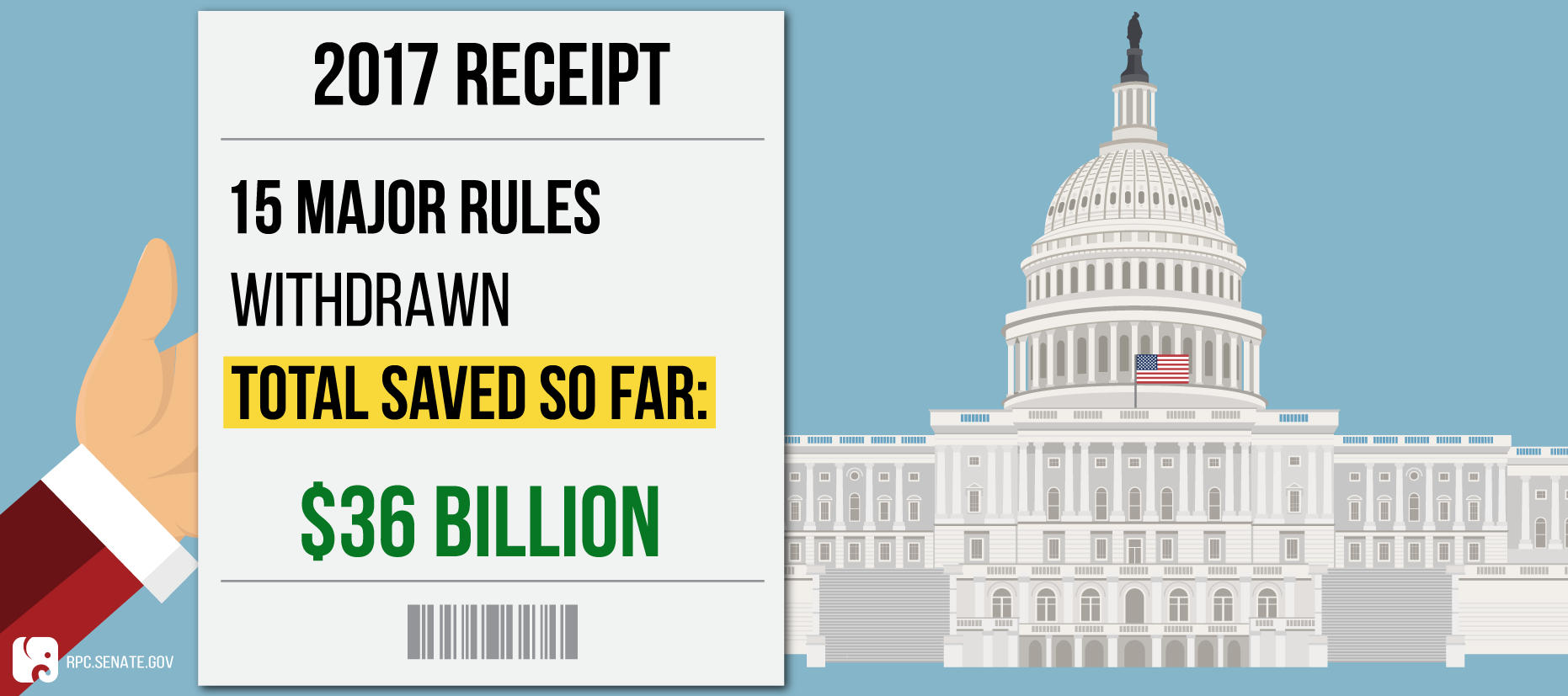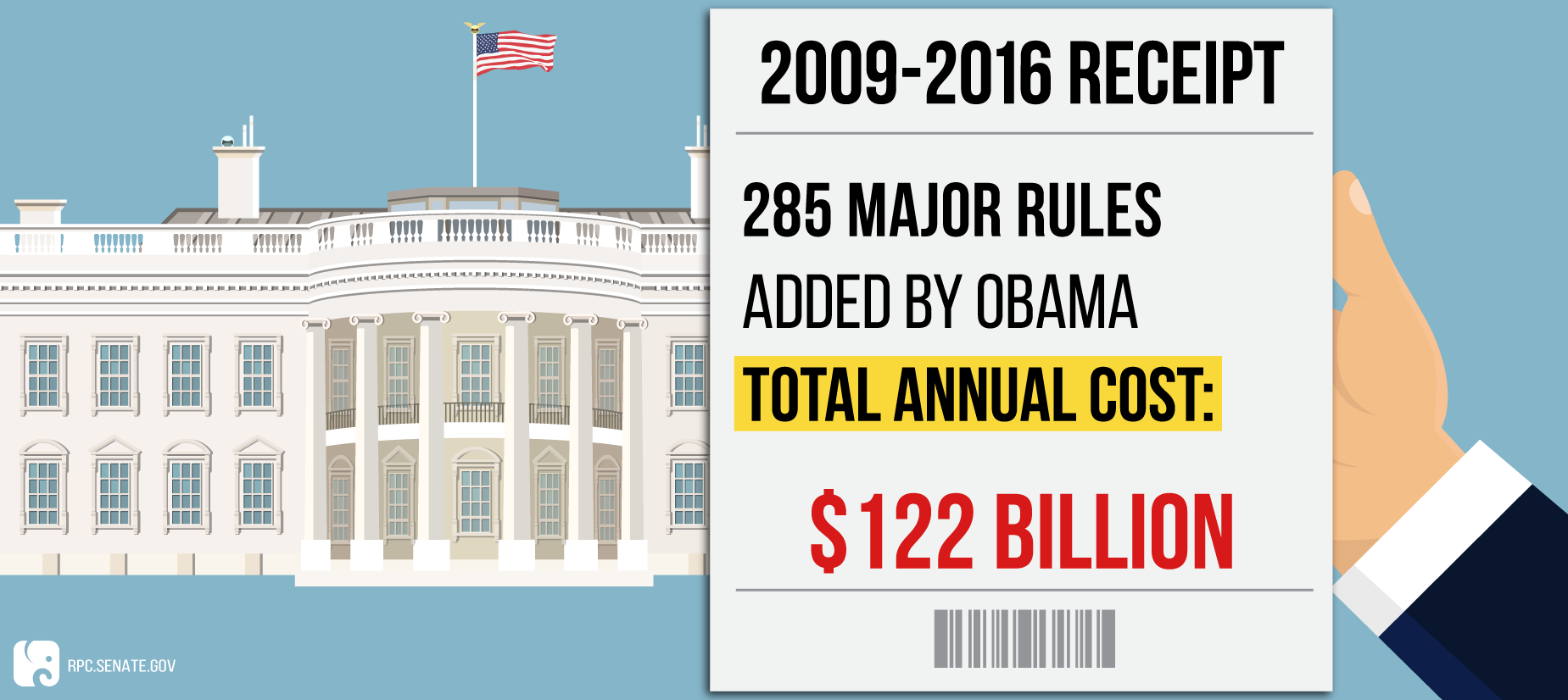The Year of the Republican Regulatory Relief
Key Takeaways
- Republicans in Congress are saving Americans as much as $36 billion by scrapping burdensome and unfair regulations.
- In Congress, Republicans repealed 15 Obama administration regulations through the Congressional Review Act.
- The Trump administration has withdrawn or reconsidered more than 860 ineffective, duplicative, and obsolete regulations.
In eight years, the Obama administration added regulations costing Americans $122 billion annually. Those regulations included 285 major rules, each costing at least $100 million per year. In 2016 alone, President Obama issued 54 major rules, 21 of which were finalized after the presidential election. This year, Republicans in Congress and the executive branch have eliminated more than 460 regulations, including 15 major rules blocked through the Congressional Review Act, and are reconsidering another 400.
Savings from Congressional Repeal of Regulations: $36 Billion

SAVING AMERICANS BILLIONS AND PROTECTING JOBS
By mid-May, Republicans in Congress had already blocked 14 Obama administration regulations through the Congressional Review Act. In October, Republicans also blocked a new Consumer Financial Protection Bureau rule that had been written during the Obama administration and finalized this summer. These efforts will save American businesses up to $36 billion in compliance costs.
The Bill for Obama Administration Regulations: $122 Billion Annually

In one CRA, Republicans in Congress stopped the federal government from destroying up to 77,000 coal mining jobs and preventing recovery of up to 65 percent of U.S. coal reserves. This “midnight” regulation was the stream buffer rule. It was finalized by the Obama administration’s Interior Department on December 19, 2016 – more than a month after the presidential election. It would have required expensive new assessments and time-consuming permitting regarding the interaction of mining and the “hydrologic balance” of the nearby area. In practice, even temporarily altering stream paths due to mining would have resulted in the de facto banning of important mining techniques, leaving up to $29 billion in coal reserves stuck in the ground. The rule also was unnecessary, given existing regulations. It would have effectively overridden the existing congressionally designed balance between state and federal regulators and imposed a one-size-fits-all federal rule. By blocking the stream buffer rule through the CRA, Congress reasserted its primacy in setting federal law.
In another notable example, Congress blocked an excessive Obama administration Occupational Safety and Health Administration regulation. The rule would have allowed OSHA to fine and cite employers for failing to track and record work-related injuries and illnesses up to five years after they occurred. Under the previous rule, OSHA could fine a firm within six months of a recordkeeping violation, a more reasonable limit that prevented the agency from issuing fines years after the fact. That final rule went into effect on January 19, 2017, the last full day of Barack Obama’s presidency. By blocking this rule, Congress saved businesses, especially in the construction industry, up to $1.2 billion in compliance costs.
THE ADMINISTRATION’S REGULATORY RELIEF
The Trump administration has provided regulatory relief without abandoning the core functions of federal agencies. Soon after the inauguration, the administration froze action on 1,985 pending Obama administration regulations for further review. Ultimately, it finalized 659 regulations in the first half of 2017. Eight of these were considered major rules, and they had a net neutral impact on the private sector.
The administration has also established a “one in, two out” rule: any new economically significant rule must be offset by two deregulatory actions. In the first six months of the year, it withdrew or removed 860 ineffective, duplicative, and obsolete regulatory actions. This includes scrapping 469 regulations the Obama administration had proposed, and reclassifying 282 regulations as “long-term” and another 109 as “inactive,” allowing for further review.
Next Article Previous Article
